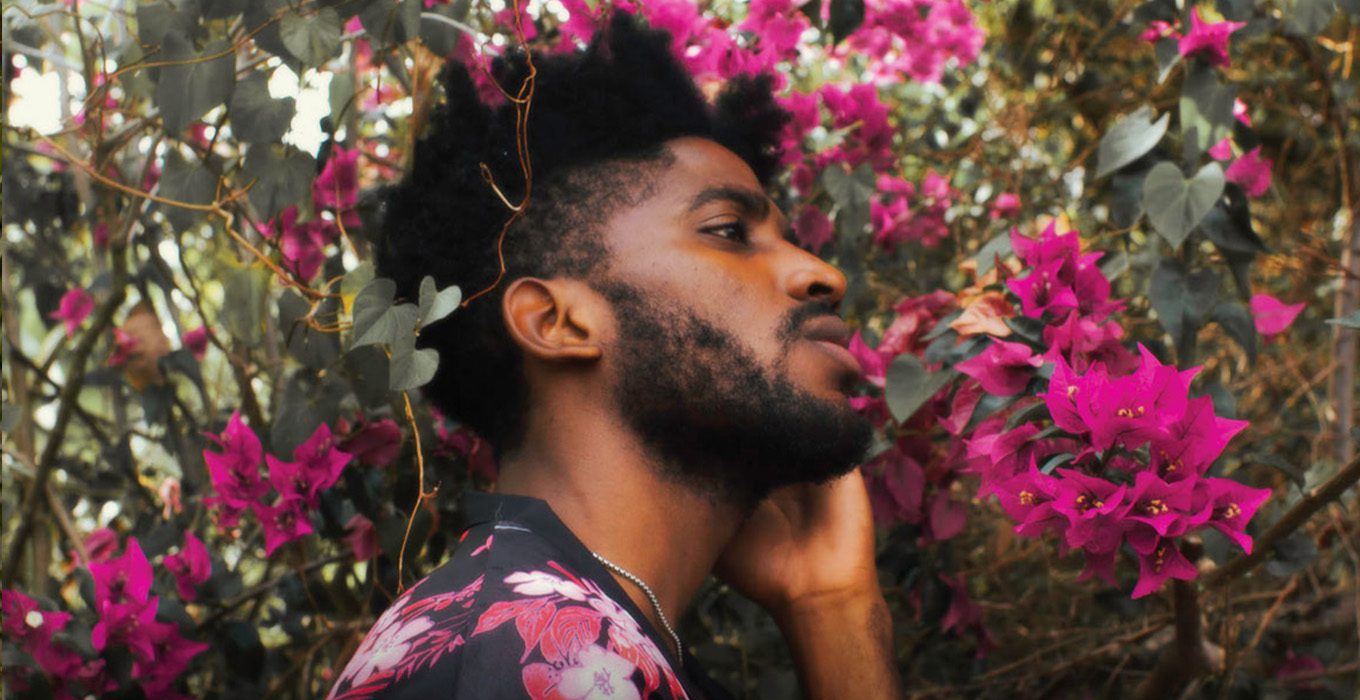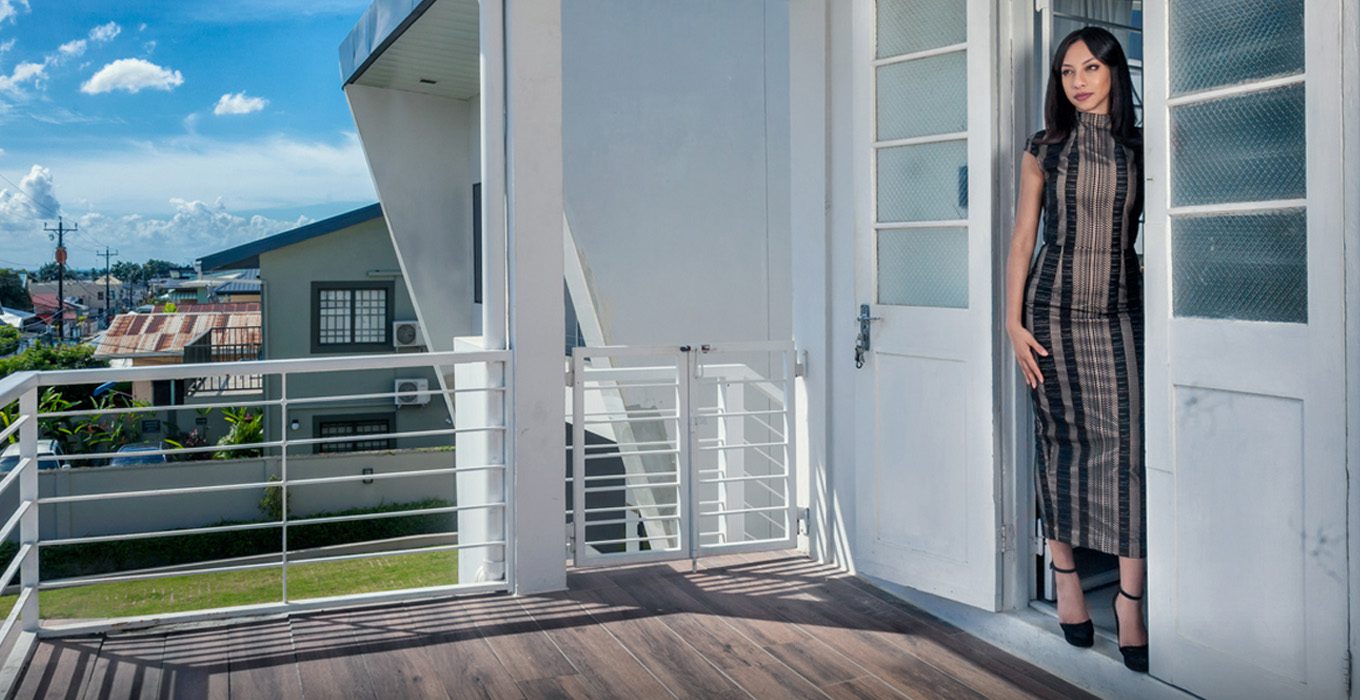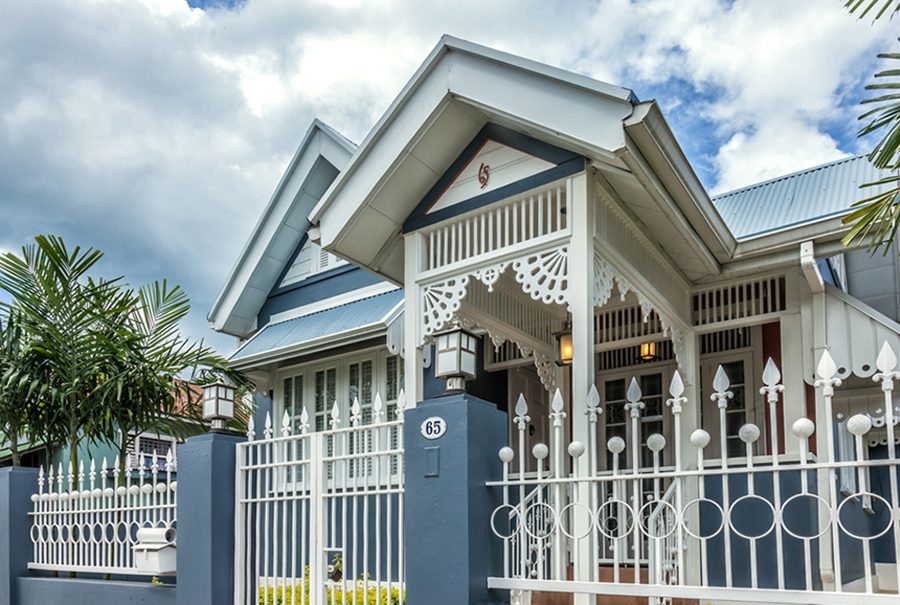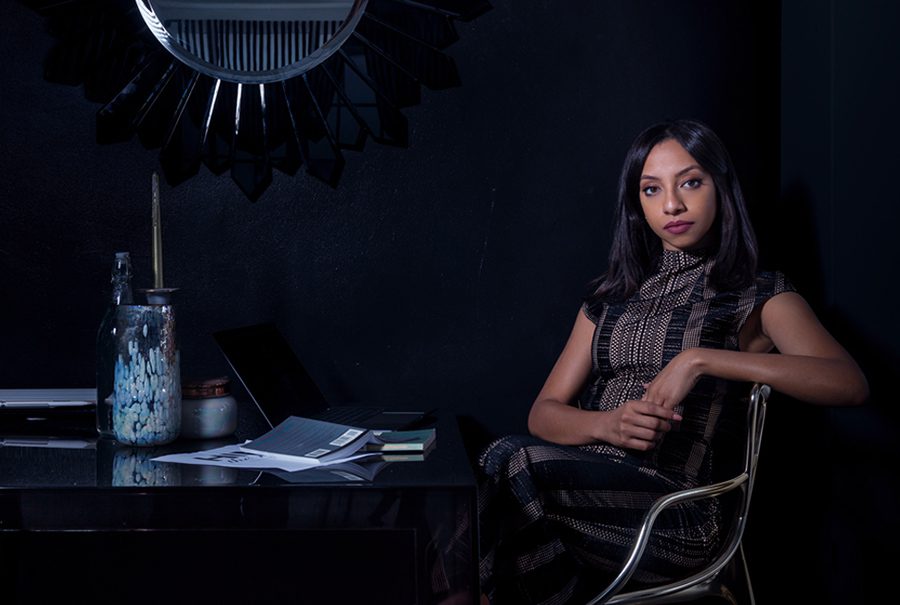

February 23, 2018
Have you noticed the little changes in the architecture in St. James? A few new gems here and there. Some subtle beautifications in Woodbrook. And the constant, albeit quiet, plea to stop tearing down our monuments.
It’s against this backdrop that we first encountered a rising, young architect with a passion for restoring traditional colonial architecture in Trinidad. At the time, Laura had recently finished the renovation of an old colonial on Gallus Street and, a couple of years later, her name popped up again, this time in the context of Carnival and costume design.
When we finally had a chance to sit with Laura in ‘The Palm House’ that she designed on Bengal Street, the conversation flowed through the varied opinions emerging on Monday mas wear, her personal passions, innate creativity and, of course, Caribbean architecture.
Laura may be more well known in some circles as an increasingly popular Monday wear luxury designer, but when she speaks about her search to better understand and define the Caribbean aesthetic through her work, that’s where the real story emerges.
“One day, even if it’s at the end of my career, I hope to help define our architecture and help Trinidadians value good design.”
Can we start with the house at 65 Gallus Street? The renovation was beautiful…
LAURA: The family that originally lived there was selling and my Dad, with his keen foresight, purchased the house.
The valuation of the house itself was actually an 8th of the value of the land, which is crazy! But they were selling and I think they were being very cautious about who they sold it to because they wanted to preserve its integrity.
My dad actually bought it hoping that my sister who’s a pastry chef would have a bakery there. But she just got back from studying in New York on a government scholarship, so she’s currently paying her dues.
In the bio on your website you said that all the little things you do for yourself are like designing yourself. I thought that was really interesting. Thinking back to your interview in the T&T Guardian about the renovation of the Gallus Street house, this Bengal house design and more recently the design of your beautiful wedding. — Were you always aware of design and consciously designing your experiences and spaces? Where do your ideas of design and creativity come from?
LAURA: It’s funny you ask that. I’ve been doing a lot of work in Woodbrook recently and I was chatting with some friends about how Woodbrook has so many creative industries existing privately. From the Big Black Box and Little Carib to all the galleries, mas camps and panyards… But in the public realm, there is no expression of creativity.
I think we have at least three squares in Woodbrook and there are no temporary installations, no showcase of anyone’s artwork. Not even markets. Nothing. It almost makes you think: how did we become so creative? How do we as a people create so much beauty with so little at our disposal?
And I think that’s how I feel about myself. You want to know what drove me to architecture? I wasn’t inspired by a building. I think that sometimes, as a creative, maybe you’re just born with it.
At home, my mother would let me do whatever. I don’t know how or why she did it but she would let me repaint all the walls. There were flowers and leaves painted with proper Sherwin Williams paint in the bathrooms and she just let me express myself. But I also remember, at St. Joseph’s Convent, that people would hate to have me in their groups projects because I would stick feathers on the cover of projects and just try to make everything extra… I couldn’t just submit a blank paper cover. I had to make sure it stood out!
“Without realizing it, you just are, who you are. Education formalizes. But, because it’s innate, you’re the one who ultimately refines it.”
As a Caribbean national, can you describe the experience of heading to Miami to study architecture?
LAURA: Before I left to go to the University of Miami, I don’t think I really knew what architecture was. I just kept saying I wanted to do it because in my mind Math + Physics + Art = Architecture.
So, about a month before I got there, I started to panic, like what am I doing?! I like makeup! I want to be a makeup artist! But my dad was like, “Never! You are going to school to do architecture. If you want to do makeup artistry you can do it after!”
And all I was thinking was, “Five years of school for architecture?” I panicked.
Architecture school and the practice of architecture are two very different things. For me studying architecture was like a fairy tale: full of fantastical projects and opportunities for practical yet artistic expression. In reality, the practice of architecture is much more business oriented.
And coming home? What made you return to T&T, instead of staying in the US after school?
LAURA: Near the end of my degree, we went to Rome for six months (which was amazing!) and then I came back to Miami to finish my last year. By then, I was just ready to come home, to be honest.
American culture is really different. They are a very consumer based society.
We have a lot of issues in Trinidad but there is a raw and humble beauty to our honesty. Trinidad is my home: it’s where I feel I belong. I’d learned so much about architecture during those five years and my goal was always to make a difference in the way we treat and understand architecture in Trinidad. It was time to come home. I’m saddened when our talent migrates, brain-drain has always been on my list of ‘don’ts’.
Have you decided as yet what you want to do now that you’re home?
LAURA: I think I want to spend the rest of my career trying to figure out what Trinidadian architecture really is. In some ways I’ve been thinking about this particular topic all my life.
We have many cultures but I’m trying to figure out what our culture is. All of us were born here, born into different ethnic groups and religious practices but what is the umbrella? Is there one? I think this question is relative to our architecture as well.
A country’s architecture is a reflection of its culture and Trinidad’s built environment is enormously complex.
I’m particularly drawn to our colonial houses. I love their symmetry, proportions and practicality but their legacy is dying. For some or, perhaps, many reasons, we feel no ownership towards these houses. I believe this is why so many of them are abandoned and left to deteriorate.
It’s such a multifaceted question but one day – even if it is at the end of my career – I hope to help define our architecture and to help Trinidadians value good design.
Besides being an architect, you also design Monday wear and costumes. When did you start pursuing costume design?
LAURA: This year is my fourth year designing costumes. It was always something I wanted to do and finally had time to when I came back from school. I thoroughly enjoyed the design of my first costume.
I was kind of surprised at how much I loved it. I think, for me, it’s almost like working a thesis. You work on this thing within the confines of a topic and then you put it out there for the sake of judgment but, no matter what, you stick to your position.
Carnival is something else. It’s crazy. Once you get involved, you realize how much it takes to have a costume or even a prototype produced. You have your wire-bender, your seamstresses, your craftsmen who put the headpieces and featherwork together for you… We have this chaotic way of production in Trinidad that’s sort of ring around but somehow it works!
Take my favourite wire-bender: he lives on a hill in Carenage, his house is always open and he’s always bareback. I’d tell him I need a wire bra or show him a drawing of some wings and he’ll whip it up in a couple minutes. Then you take this skeleton of a thing and you go to a production expert and ask “How do I get the feathers to fall this way?” and he’ll work it out, knowing just what to do like the back of his hand. And they don’t dig out your eye for the advice and expertise: they just give it, because making mas is their passion.
After the first year of designing costumes, I was hooked. But it’s a lot of work! Especially if it’s not your full time job. You’re running here and there and a lot of money is spent producing a costume but, at the end of the day, it’s not very profitable. People genuinely do this because they love it.
And your Monday wear? In one of your blog posts you said something that I absolutely loved. You describe designing Monday wear as designing for a thousand brides.
LAURA: Oh gosh! Let me tell you something: Monday wear is a different ball game entirely! Well, for me, at least. Because, as a costume designer, you create your design and then submit your prototype to the band. If they accept it, they produce it and you’re done. But for Monday wear, I do all the production. I have to work with the seamstresses to have them produced.
Last year was crazy. I think a big mistake I made was that I distributed the Monday wear too early. I was ready by February 4th and Carnival Monday was February 27th. So my clients had their pieces in hand for too long. They were trying them on and nit-picking but customer service is a huge deal to me. The client has to be happy, so if she wants to take it in there an ‘umph’, I’ll take it in there an ‘umph’. It can get quite crazy.
That’s the culture of Carnival. That’s what Carnival has become. People are so self-conscious that you’ll ruin it for them if their costume doesn’t look exactly as they envision it. For months they’re working on their bodies. They have their hair, their makeup, their spray tans. Everything is done. They have to look like queens in their costumes.
But Carnival wasn’t always like this. When I started playing in Convent, I didn’t care about any of that. I just wanted the beads to be jiggling on my butt!
Have you noticed any similarity between architecture and Carnival design?
LAURA: Definitely. They’re so similar. The main focus is always proportion. I always see when something is just wrong. Whether there are too many strings of beads on a costume or the columns of a building are too tall, I think my eye for proportion is the same. There’s also the design process – from sketching something on paper to figuring out how to engineer that thing so it becomes exactly what you sketched.
I’ve noticed that some of my design colleagues in the costume industry don’t sketch. They put things together as they go and that’s cool, too, but I think because I’m an architect, the way I design houses and buildings is the same way I design for Carnival.
As an architect, there is a learned respect for design, the design process and the history of design and we see it very clearly in your architecture work with the revitalization of historic buildings. But then there are your costume and Monday wear designs, which might seem like a complete departure from the way you approach architecture. It might also seem like it isn’t very creative or very true to representing what Trinidad Carnival and costume design. What would you say in response to that?
LAURA: I think it’s the same in architecture. I wouldn’t necessarily replicate a colonial building today. Our way of life has changed drastically since the 1800s. I think there’s so much to learn from the past and so much that can be applied to today, but today is different from yesterday.
In Trinidadian architecture, the old exists with the new. It’s important to recognize our history in order for us to understand how we came to be today. Does it mean that we need to continue recreating the past? No. Does this mean that we need shake our history? NO. Our task lies in finding a happy balance where old and new can amicably co-exist and accept each other’s place today.
In either instance – mas or architecture – it’s going to be really, really hard to design something from yesteryear for today. We’re still struggling as a culture with the stark difference between traditional mas and the mas of today. But, at the end of the day, Carnival is a business and history in this country is a particularly tough sell.
Many people want something they literally feel cool in, something that allows you to lose yourself on the road. It’s not really about a theme any more.
Designing for me is more about creating a feeling rather than expressing a theme, which is what I think Lost Tribe and K2K are about and do beautifully. I just want everyone to feel something when they play. We’ve been shamed into thinking that this type of mas is void of creativity and I simply don’t agree. If my costume can transform you emotionally, I’ve done my job. Once we have accepted that the experience of mas can also be a very personal one, then this concept may be easier to swallow. We may call it vain or self-absorbed or narcissistic – but, so what? I think that we should be allowed to feel incredibly radiant and powerful and beautiful and sexy and strong and confident and happy – shamelessly – for at least 2 days of the year.
If you could go back in time and give ‘now starting architecture school Laura’ some advice, what would you tell her?
LAURA: I would tell her, the sky is the limit, not to waste time doubting her potential and to be as critical in her thinking as possible. I’d tell her to ask questions without hesitation.
The Laura going into school was so worried and insecure. I think we all have so much unearthed potential but confidence is the driving force behind what we actually accomplish. Go with your instincts – there’s no time for hesitation.
Thanks for chatting with us Laura.
lauranarayansingh.com



INTERVIEWER: TANYA MARIE PHOTOGRAPHER: DAMIAN LIBERT